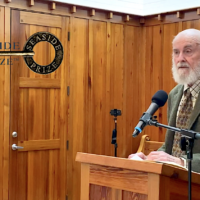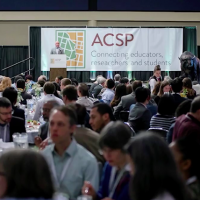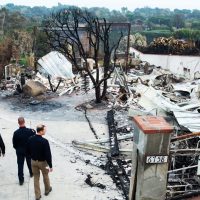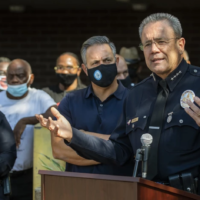UCLA Professors Win $956,000 Award to Tackle Rising Heat in L.A. Communities Scholars from Urban Planning, Institute of Transportation Studies and Luskin Center for Innovation join cross-campus effort to find climate solutions
A team of 10 UCLA professors has earned a $956,000 award for a project that will combine their expertise in engineering, urban planning, public health and environmental law to address the rapid increase in the number of extreme heat days in Los Angeles.
The prize is funded by a 2015 donation from the Anthony and Jeanne Pritzker Family Foundation.
The project, called Heat Resilient L.A., will over the next two years determine where and when people moving around the city are most vulnerable to the effects of extreme heat — a problem being caused by climate change — and assess which communities most need cooling interventions.
Based on their findings, the team will design new cooling structures and work with local stakeholders to determine where they should be installed. The team has designed a prototype structure that resembles a bus stop shelter, but in addition to a roof that provides shade, it also uses a combination of radiant and evaporative cooling technologies to provide “passive cooling” for those nearby.
Throughout the project, the researchers plan to engage directly with communities to produce the best possible design for the cooling structures and choose the best possible locations. Among the elements that helped the project stand out: its focus on equity and community engagement, and its use of devices other than shade and trees to provide cooling for local hot spots.
“What’s unique right now is that we have access to a portfolio of solutions and technologies that hadn’t been either thought of as plausible solutions or, frankly, available even just a few years ago,” said Aaswath Raman, a member of the Heat Resilient L.A. team and an assistant professor of materials science and engineering at the UCLA Samueli School of Engineering. Raman, who is designing the cooling structures using technology that has been developed in recent years at UCLA and elsewhere, said the project is an opportunity to explore the real-world use of emerging cooling technologies and materials.
That should not only help Los Angeles communities but also provide insights that he and others can use to continue building better technologies.
‘We wanted to bring together brilliant minds at UCLA who had never collaborated before, and push them to bring fresh ideas to the table.’ — Cassie Rauser, executive director of the UCLA Sustainable LA Grand Challenge
The winning project was chosen through a new UCLA initiative that upended the traditional model for conceiving and funding research projects. The program, called the Sustainable LA Grand Challenge Sandpit, emphasized connection, experimentation and blue-sky thinking.
In all, eight teams made up of more than 60 faculty members from 27 UCLA departments participated.
The program culminated in December with an online pitch event that worked more like the TV show “Shark Tank” than a typical call for proposals. Instead of preparing dense written submissions, the teams had to sell their research projects — all focused on sustainability — to a panel of jurors that included UCLA deans as well as chief sustainability officers from the city and county.
The Heat Resilient L.A. pitch was led by Raman; V. Kelly Turner, an assistant professor of urban planning at UCLA Luskin; and David Eisenman, a professor in residence at the David Geffen School of Medicine at UCLA and at the UCLA Fielding School of Public Health.
The other members of the winning team are Cara Horowitz, co-executive director of the UCLA Emmett Institute on Climate Change and the Environment; Sungtaek Ju, professor of mechanical and aerospace engineering, and of bioengineering; Travis Longcore, associate adjunct professor at the UCLA Institute of the Environment and Sustainability; Juan Matute, deputy director of the UCLA Institute of Transportation Studies; Gregory Pierce, associate director of the UCLA Luskin Center for Innovation; Kirsten Schwarz, associate professor of urban planning; and Walker Wells, lecturer in urban planning.
“The sandpit was definitely not business as usual, and that was the point,” said Cassie Rauser, executive director of the UCLA Sustainable LA Grand Challenge, a campuswide initiative to help transform Los Angeles into the world’s most sustainable megacity by 2050. “We wanted to bring together brilliant minds at UCLA who had never collaborated before, and push them to bring fresh ideas to the table. This type of interdisciplinary problem-solving is absolutely critical for addressing Los Angeles’ complex sustainability challenges.”
Competitors were invited to develop projects that directly address goals outlined in sustainability plans put forward by Los Angeles County and the city of Los Angeles, while paying particular attention to environmental justice and equity. The “sandpit” name was meant to encourage participants to bring a childlike sense of curiosity, openness and possibility into the process.
Teams and research concepts formed over the course of three months of online workshops designed to push participants out of their disciplinary bubbles and intellectual comfort zones — a critical aspect of the experience, according to Turner, who has studied what makes interdisciplinary collaborations work.
“So often it is about the informal interactions that get folks comfortable with being uncomfortable with each other, so that they can come up with the really innovative ideas,” she said.
The seven teams that did not win the grand prize will each receive $25,000 in seed funding from the Sustainable LA Grand Challenge, which will also provide continued research development support to help the teams further develop their ideas and pursue full funding from external organizations.
“One of the most exciting aspects of the sandpit is that we heard eight fantastic pitches,” said Eric Hoek, a UCLA professor of civil and environmental engineering and director of the Sustainable LA Grand Challenge. “Any of those projects could make a significant, tangible contribution toward our city’s and county’s sustainability goals, and we’re excited to help them all realize their potential.”










Leave a Reply
Want to join the discussion?Feel free to contribute!